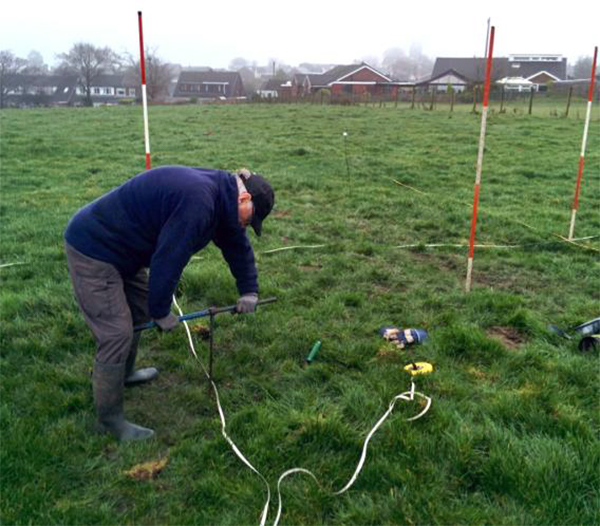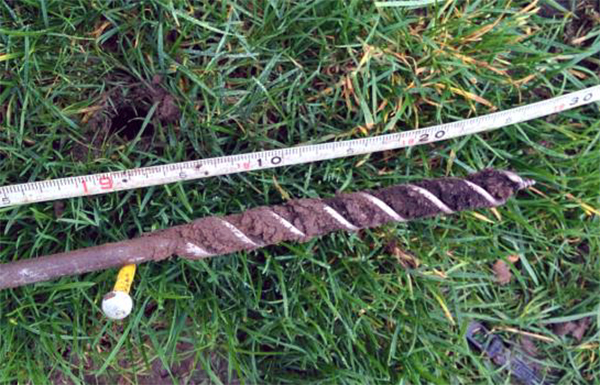
With more restrictions looming and winter beginning to set in, Alan Bury and I took the opportunity to get out for one last go in the field east of Dark Lane in Blackrod (we would have gone earlier but had to wait for the cows to be brought in for the winter). In last year's excavation there, we were looking for a reputed structure known as Chisnall's Summer House. The dig produced little (if any) evidence of occupation on the site we chose. The notable exception, however, was what we perceived to be a ditch cut into the bedrock which lay not far below the surface (Newsletter No.226). Due to the lack of time on the day, we weren't able to investigate it fully, but since then Alan Bury has been looking at ways to explore the feature by other means. Last year's resistivity survey here had emphatically failed in detecting anything resembling the ditch. A GPR survey seemed to be a reasonable alternative but, as field was very bumpy and strewn with cow pats, it was difficult to imagine how a successful operation could be achieved. I proposed therefore that a coring survey might prove more productive. It's something we haven't tried before but seemed to suit the conditions presented. On a wet Thursday morning therefore, we set off in search of our previous excavation. Once found, probing with steel rods gave clues as to where we should start our survey. Two parallel scans were then marked out 2m and 4m north of our previous work. Our corer is 1m long and, although only 20mm diameter, can be difficult work in heavy clay soils. Here, however, the soil and subsoil is relatively soft, we were therefore able to carry out quite a number of cores before having to give in to our wet and aching limbs. The result we obtained did reveal more of the rock cut feature, showing it to be over 4m wide. However it was no more than 50cm deep and when plotted with our previous result, the pattern suggests a shallow depression rather than ditch. Our corer was also bringing up black organic material from the deepest parts. This shows perhaps that it was open for a period of time before being backfilled which suggests landscaping activity at some point.

As a coring exercise it was very useful, demonstrating that, when the conditions are right, a relatively large area can be investigated with a minimum of disruption. Alan Bury is encouraged and continues with his plans for further investigations. He's also hoping to get local involvement and perhaps funding for more extensive work next year (including another dig). More details here.
CBA NW Autumn Conference
This is to take place this Saturday (21st November) and as you can guess due to the virus, will be via Zoom. As usual it will be a round up of projects that have happened over the last 12 months, particularly those helped with funding from the CBA NW. For more information about the programme and booking details visit their website here.
Books for Christmas
If you're stuck for presents this Christmas we have two book s written by members of our Society. The first, by Mike Keulemans, is entitled 'Never To Sail In Her: Queen Victoria's Last Royal Yacht' published by Chaffcutter Books. Although not cheap at £45, it does contain 240 historic photos and has a forward by none other than H.R.H. Prince Philip, Duke of Edinburgh.
The second, a novel by our chairman Patrick entitled 'Thegn', is perhaps a little more affordable at £9.99 for the paperback (or even better £2.99 for the electronic version). Set at the time of the Battle of Hastings, it tells the story of Edgar, grandson of the Thegn of Rapendun who gets embroiled in the fight to defend his people against the savage invasion by the Normans. Both are available on the usual on-line book stores.
On the Web
Time Team Teatime . If you're a fan of the programme you'll enjoy this site which has interviews with behind the scenes individuals discussing old episodes and answering questions about how they were achieved the digs in just in 3 days.
Lindisfarne: before and after the Vikings. A short video reconstruction of what Holy Island would have looked like before the dramatic events at the end of the 8th century. It was created by DigVentures who have been excavating there all season - here is their story.
Keep safe - BA
|



